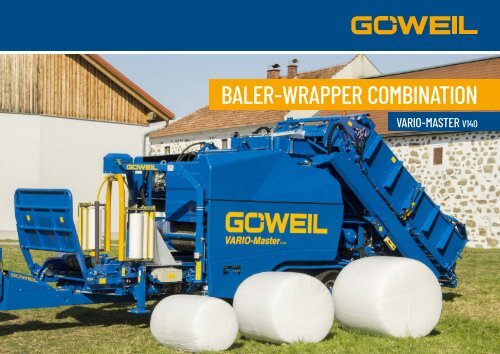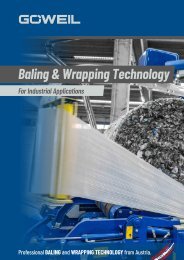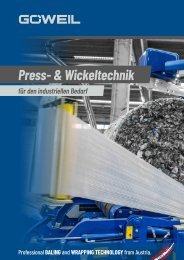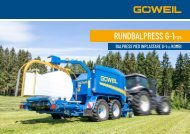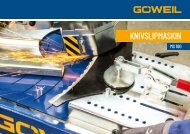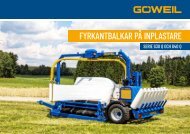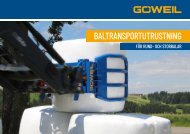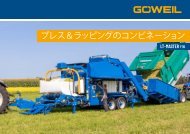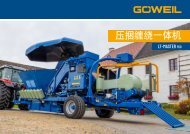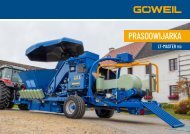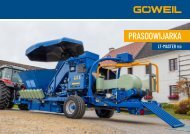EN | VARIO-Master V140 | Baler-Wrapper Combination | Goeweil
The VARIO-Master is capable of turning a large number of materials including maize, CCM, alfalfa, sugar beet pulp, grain, mixed feed, hemp into perfectly shaped round bales. The variable bale chamber makes it possible to produce highly compacted bales with a diameter of 80 - 140 cm. The seamless work flow provides for maximum compression and quick exclusion of air.
The VARIO-Master is capable of turning a large number of materials including maize, CCM, alfalfa, sugar beet pulp, grain, mixed feed, hemp into perfectly shaped round bales. The variable bale chamber makes it possible to produce highly compacted bales with a diameter of 80 - 140 cm. The seamless work flow provides for maximum compression and quick exclusion of air.
Create successful ePaper yourself
Turn your PDF publications into a flip-book with our unique Google optimized e-Paper software.
BALER-WRAPPER COMBINATION<br />
<strong>VARIO</strong>-MASTER <strong>V140</strong>
GÖWEIL<br />
MASCHIN<strong>EN</strong>BAU GMBH<br />
The name Göweil has been synonymous with the highest quality product range in the bale wrapping and baling technology sector since<br />
1988.<br />
Other core areas include the manufacture of bale opening and transport devices, high lift buckets as well as blade sharpeners.<br />
MECHANICAL <strong>EN</strong>GINEERING AT THE HIGH-<br />
EST LEVEL<br />
Professional solutions for the agro-industrial sector<br />
As an exceptionally high portion of its products are exported, GÖWEIL machines<br />
have become renowned and are widely used throughout the world.<br />
The company originally specialized in the production of agricultural machines, but<br />
its machines are now also available for industrial use.<br />
GÖWEIL is characterized by the following four values:<br />
QUALITY.<br />
All products are designed, developed,<br />
and produced at the company's sites<br />
in Kirchschlag and Rainbach (Upper<br />
Austria).<br />
EFFICI<strong>EN</strong>CY.<br />
By continuously developing our<br />
product range, we offer high-quality<br />
and efficient solutions in keeping with<br />
the times.<br />
KNOW-HOW.<br />
Years of experience, as well as close<br />
cooperation between design and<br />
manufacturing, are the keys to our<br />
well-thought-out solutions.<br />
SERVICE.<br />
Even the best machine needs maintenance.<br />
Our service team is there for<br />
you and will take care of your request.<br />
Company locations in Kirchschlag (above) and Rainbach (below)<br />
2
OUR SOLUTIONS:<br />
BALER-WRAPPER COMBINATION<br />
<strong>VARIO</strong>-MASTER <strong>V140</strong><br />
INTRODUCTION 4 - 5<br />
<strong>VARIO</strong>-<strong>Master</strong> further development & highlights<br />
SILAGING 6 - 7<br />
Definition of silage & optimal feed quality<br />
MATERIALS 8 - 9<br />
Overview of materials suitable for baling and wrapping<br />
THE HIGHLIGHTS 10 - 11<br />
Components & benefits of the <strong>VARIO</strong>-<strong>Master</strong> <strong>V140</strong><br />
SETUP & PREPARATION 12 - 13<br />
All about the workflow<br />
MATERIAL FLOW 14 - 15<br />
Depiction of the material flow<br />
EQUIPM<strong>EN</strong>T 16 - 22<br />
Basic model, additional equipment, technical<br />
data, and required connections<br />
SERVICE 23<br />
About our GÖWEIL Service Team<br />
3
<strong>VARIO</strong>-MASTER <strong>V140</strong><br />
FURTHER DEVELOPM<strong>EN</strong>T<br />
For decades, the world-renowned LT-<strong>Master</strong> and <strong>VARIO</strong>-<strong>Master</strong> baler-wrapper combinations have been an important component in the preservation<br />
of feed. The range of materials that can be processed into round bales has expanded enormously and the demand for variable bale<br />
sizes has also steadily grown - reason enough to equip the <strong>VARIO</strong>-<strong>Master</strong> <strong>V140</strong> with the latest features of the <strong>Master</strong> series!<br />
EXPERI<strong>EN</strong>CE COUNTS<br />
The high compression of the material, the rapid expulsion of air from the bales as well<br />
as a totally clean production process are crucial for ensuring the highest feed quality<br />
in silage bales.<br />
GÖWEIL guarantees exactly that with the new generation of the <strong>VARIO</strong>-<strong>Master</strong> <strong>V140</strong>.<br />
Each bale also forms a small unit that can be used as feed quickly and easily. Additional<br />
advantages include:<br />
• Easy and inexpensive storage and transport of round bales<br />
• Simple production of mixed feeds (TMR)<br />
• Corn silage usage in summer feeding<br />
VERSATILITY PROVIDES THE EDGE:<br />
Due to the unique overall solution offered by GÖWEIL with the <strong>VARIO</strong>-<strong>Master</strong> <strong>V140</strong>, more<br />
and more small chopped materials - such as alfalfa, grain, sugar beets, or even waste<br />
and plastics - are being processed into round bales. Compaction rates of between 30%<br />
and 70% can be achieved depending on the size and structure of the material.<br />
Customers now include not only contractors, but also large-scale agricultural and industrial<br />
enterprises.<br />
4
<strong>VARIO</strong>-<strong>Master</strong> <strong>V140</strong><br />
THE NEW <strong>VARIO</strong>-MASTER <strong>V140</strong><br />
With the <strong>VARIO</strong>-<strong>Master</strong> <strong>V140</strong>, GÖWEIL is presenting an overhauled model of the variable baler-wrapper combination. In addition to the<br />
variable bale chamber, the silage baler impresses with a range of innovations that offer operators greater convenience and flexibility<br />
when using the machine.<br />
THE HIGHLIGHTS AT A GLANCE:<br />
Hydraulically powered variable bale chamber<br />
The hydraulically powered variable bale chamber can produce bale sizes between 80<br />
and 140 cm (32” - 55”). This is a major advantage in both bale logistics and feed operations.<br />
During the baling and binding process, it is possible to choose between four<br />
different speed levels.<br />
Multicrop feeder<br />
In order to better process the many different materials, the feeder has been equipped<br />
with a dosing drum.<br />
Dosing drum of the Multicrop feeder<br />
PROFI plus L terminal<br />
The <strong>VARIO</strong>-<strong>Master</strong> <strong>V140</strong> is operated with the PROFI plus L terminal. The user interface is<br />
structured intuitively and enables easy operation of the machine.<br />
The new PROFI plus L terminal<br />
5
<strong>VARIO</strong>-<strong>Master</strong> <strong>V140</strong><br />
SILAGING<br />
In principle, all green forages can be processed into silage. In addition to grass silage, corn silage is the most commonly used feed in dairy<br />
cattle farming. While alfalfa and clover silages are very rich in protein, corn silage boasts the highest energy content next to grass silage<br />
due to the starch. The exact silaging sequence is explained here:<br />
INFO<br />
SILAGING<br />
The chopped mass is wrapped completely airtight and stored. The residual sugar from<br />
the chopped material and deoxygenation give rise to the process of lactic acid fermentation.<br />
The silage acidifies, which makes it keep well. Silage is a high-quality and<br />
important feed for livestock in particular.<br />
If the silage is too wet or contains too much residual oxygen, it can lead to undesirably<br />
high levels of acetic or butyric fermentation. This renders the silage inedible for livestock<br />
and brings with it the risk of sickness caused by toxic excretory products.<br />
Efficient silaging with the <strong>VARIO</strong>-<strong>Master</strong> <strong>V140</strong> baler-wrapper combination can eliminate<br />
multiple potential hazards:<br />
• Very high compression during the baling process means optimal keeping quality<br />
and the best-possible feed quality<br />
• Particularly fast air-tight seal through an optimized baling-wrapping process<br />
• Totally clean production process and therefore no feed impurities<br />
• No risk of secondary fermentation or subsequent warming<br />
6
OPTIMAL FEED QUALITY<br />
Every farmer wants to provide their animals with the best-possible feed. Using silage<br />
offers a number of benefits and has become virtually indispensable to modern feeding.<br />
In order to achieve first-rate silage quality, several factors need to be considered. The<br />
high compression of the feed is top priority along with a rapid air-tight seal and a<br />
clean production process. This is all combined to optimal effect by the <strong>VARIO</strong>-<strong>Master</strong><br />
<strong>V140</strong>.<br />
A study by The Agricultural Research and Education Center Raumberg-Gumpenstein<br />
clarifies the difference between the compression of corn silage for bunker silos and<br />
round bales:<br />
kg DM/m³<br />
COMPRESSION OF CORN SILAGE<br />
INFO<br />
250<br />
239 239<br />
Significant differences can be identified in the density of corn silage:<br />
A<br />
B<br />
200<br />
Bunker silo 148 kg DM/m³ (9 lbs DM/ft³) 120 kg DM/m³ (7.5 lbs DM/ft³)<br />
Round bales 239 kg DM/m³ (15 lbs DM/ft³) 239 kg DM/m³ (15 lbs DM/ft³)<br />
150<br />
148<br />
Corn silage bales Standard Variable bale size<br />
Diameter 1.15 m (3’ 9”) 0.60 - 1.15 m (2’ - 3’ 9”)<br />
100<br />
120<br />
Width 1.20 m (4’) 1.20 m (4’)<br />
Weight (at 29% DM)<br />
~ 1,100 kg (880 kg/m³)<br />
(~ 2,400 lbs)<br />
~ 300 - 1,100 kg (880 kg/m³)<br />
(~ 660 - 2,400 lbs)<br />
Volume 1.25 m³ (44 ft³) 0.35 - 1.25 m³ (12 - 44 ft³)<br />
50<br />
Round bales A Bunker silo A Round bales B Bunker silo B<br />
Corn<br />
silage<br />
"For silage round bales, microbial group 2 is strikingly low (bacteria associated with spoilage:<br />
bacillus, micrococcus, coagulase-negative species of staphylococcus - orientation<br />
value: 200) with values of 6.0 - 6.5 CFU/g. This can be attributed to particularly rapid<br />
anaerobic storage."<br />
Source: LFZ Raumberg-Gumpenstein - Pöllinger 2011<br />
7
<strong>VARIO</strong>-<strong>Master</strong> <strong>V140</strong><br />
MATERIALS<br />
1<br />
The large variety of materials suitable for baling and wrapping means that the <strong>VARIO</strong>-<strong>Master</strong> <strong>V140</strong> can be used for a wide range of purposes. As<br />
a result of the various harvest times, the machine is used to capacity all year round. This guarantees maximum efficiency and utilization.<br />
The most common materials at a glance:<br />
4<br />
7<br />
1 CORN<br />
Corn silage is produced using the entire corn plant and serves as one of the most<br />
important staple feeds for livestock with high milk yields. Corn silage provides<br />
particularly nutritious energy in the form of starch from crushed corn grains and<br />
is also very rich in fiber. In this way, corn silage provides the optimal conditions<br />
for achieving maximum milk or fattening yields. Particularly at temperatures<br />
above 15 degrees Celsius, the feed can deteriorate in quality due to the high activity<br />
of microbacteria. The very high compression during the <strong>VARIO</strong>-<strong>Master</strong> <strong>V140</strong><br />
baling process achieves unmatched keeping and feed quality.<br />
2<br />
CCM<br />
2<br />
5<br />
8<br />
CCM (corn-cob-mix) is an excellent energy feed made from the cob and kernels of<br />
the corn cob. It is used to feed pigs, cattle, and other small ruminants. CCM silage<br />
offers the maximum energy concentration through additional starch and has an<br />
excellent price-performance ratio in comparison with traditional concentrated<br />
feed. The crushing of corn grains gives the feed more structure and makes it very<br />
easy for livestock to pick up. Due to their compact shape, CCM silage bales are<br />
perfectly easy to handle and also ideally suited to feeding in smaller quantities.<br />
3<br />
6<br />
9<br />
3 ALFALFA<br />
Alongside corn silage, alfalfa silage is one of the most important basic feed components<br />
in cattle feeding. High feed intake as well as particularly high structural<br />
effectiveness contributes to substantial cattle milk yields. The cultivation of alfalfa<br />
offers high yield security and also improves the quality of the soil. However, its low<br />
sugar content makes alfalfa very difficult to preserve using traditional methods.<br />
Processing into round bales using an <strong>VARIO</strong>-<strong>Master</strong> <strong>V140</strong> significantly enhances<br />
the silage quality of alfalfa thanks to the rapid air-tight seal and effective compression.<br />
8
4<br />
SUGAR BEETS<br />
7 GRAIN WPS<br />
Compressed corn silage bales<br />
Pressed sugar beet pulp silages are characterized by a very high energy<br />
content, they are easily digestible, and impress with their palatability.<br />
They are an ideal supplement to grass silages since they have a negative<br />
ruminal nitrogen balance and thereby compensate for the protein balance<br />
in the stomach. Pressed beet pulp silages have very low lactic acid<br />
content and therefore also a very low total acidity. High compression as<br />
well as clean processing while still warm are hugely important for silage<br />
quality. <strong>VARIO</strong>-<strong>Master</strong> <strong>V140</strong> round bales also cool down faster and can<br />
therefore be used for feeding sooner.<br />
Cereal grain whole plant silages tend to be produced using barley, wheat,<br />
or triticale. Cultivation provides a very reliable yield and has benefits in<br />
the field of crop management. However, cereal grains have a very low<br />
energy content and is difficult to ensile using traditional methods. Optimal<br />
compression and the rapid air-tight seal make it easy to produce cereal<br />
grain silage with the <strong>VARIO</strong>-<strong>Master</strong> <strong>V140</strong>.<br />
Compressed CCM bales<br />
5 TMR – TOTAL MIXED RATION<br />
A TMR contains a balanced mix of staple forage and concentrated feed.<br />
Dry matter content and energy content are perfectly coordinated. TM rations<br />
have a very positive effect on milk yields and animal health. Previously<br />
fermented silages are mixed and ensiled again for stockpiling TMR.<br />
The <strong>VARIO</strong>-<strong>Master</strong> <strong>V140</strong> can be used to produce TMR inventory quickly,<br />
easily, and inexpensively. It is transportable and therefore an ideal solution<br />
for trade.<br />
8<br />
GRASS<br />
Grass silage serves as the most important staple forage for livestock. The<br />
feed is made from an optimal combination of sweet grasses, herbs, and<br />
clover. Grass types with a high sugar content guarantee a good fermentation<br />
process. Thanks to the <strong>VARIO</strong>-<strong>Master</strong> <strong>V140</strong>, even grasses with a higher<br />
fiber content can be optimally processed due to the high bale density.<br />
Compressed grass bales<br />
6 WOOD / WOOD SHAVINGS<br />
Be it wood shavings, wood wool, bark mulch, wood chips, or pellets, the<br />
<strong>VARIO</strong>-<strong>Master</strong> <strong>V140</strong> can be used to press all materials into compact bales.<br />
This makes transport easier and also saves on expensive storage locations.<br />
The bales can be transported with a tractor, stacked, or loaded onto<br />
a pallet. Pressed into a bale, the material stays clean and dry.<br />
9<br />
RDF SUBSTITUTE FUELS<br />
The storage of garbage and waste is an ever-growing problem. Some materials<br />
are prepared for further processing and used as substitute fuels.<br />
The <strong>VARIO</strong>-<strong>Master</strong> <strong>V140</strong> offers a quick and easy solution to the associated<br />
storage and transport problems. Compressed bales can be transported<br />
compactly and are ideally suited to temporary storage. In principle, solid<br />
residues such as plastic, domestic refuse, shredded carpet, and even<br />
compost can be processed into round bales.<br />
Compressed sugar beet pulp bales<br />
OTHER MATERIALS ALREADY PROCESSED INTO ROUND BALES INCLUDE:<br />
Wild animal feed, vegetable waste, sugar cane, crushed grain corn, horse manure, apple pomace, straw, hemp<br />
9
<strong>VARIO</strong>-<strong>Master</strong> <strong>V140</strong><br />
THE HIGHLIGHTS<br />
BALER<br />
ELEVATOR<br />
WRAPPER<br />
3<br />
2<br />
1<br />
1<br />
FEEDING SYSTEM / DOSING<br />
10<br />
Low-profile design:<br />
The low profile design and 3.50 (11’ 6”) meter width of the feeder make the filling<br />
process quick and easy – whether you use a dump trailer, push-off trailer, truck, or<br />
direct feeding.<br />
Large-capacity Multicrop feeder:<br />
The Multicrop feeder provides a large buffer with a volume of around 13 m³ (17 yd³).<br />
This large capacity keeps the <strong>VARIO</strong>-<strong>Master</strong> <strong>V140</strong> running during feeding.<br />
In order to better process the many different materials, the feeder has been<br />
equipped with a dosing drum. This and the feed screws ensure the even flow of<br />
materials on the elevator and also optimally process fibrous material such as grass<br />
and alfalfa.<br />
Scraper floor:<br />
The speed of the scraper floor adapts to the quantity of material and is automatically<br />
self-regulating. The galvanized, die-forged scraper floor chains from Rübig used<br />
on the elevator and feeder are indestructible.<br />
CONTROL SYSTEM<br />
Program control PROFI with PROFI plus L terminal<br />
The <strong>VARIO</strong>-<strong>Master</strong> <strong>V140</strong> is operated with the PROFI plus L terminal. The user<br />
interface is structured intuitively and enables easy operation of the machine.<br />
The entire work process as well as the machine settings are depicted via the<br />
display. Via the terminal's USB port, the language and customer logos for the<br />
weighing system with label printer can be imported with ease and customer<br />
account data exported in CSV format.
2<br />
BALER<br />
3<br />
WRAPPER<br />
FEEDER<br />
Hydraulically powered variable bale chamber:<br />
Two bale chamber belts permanently ensure high compression of the material.<br />
Bale diameter and bale density are set on the terminal. The round<br />
bales can be pressed with a diameter from 80 to 140 cm (32“ - 55“), adjustable<br />
in 5 cm (2“) steps. The hydraulic drive allows the speed of the bale<br />
chamber to be adjusted to the baled material in four stages.<br />
High bale density:<br />
The 4 mm thick steel rolls are reinforced on the inside; the ribbing ensures<br />
optimal bale density and secure rotation of the bale.<br />
Long service life:<br />
Large, sealed bearings and a perfectly adapted lubrication system guarantee<br />
a long machine service life.<br />
Net or film:<br />
An efficient binding system is needed to keep a bale in perfect condition.<br />
The <strong>VARIO</strong>-<strong>Master</strong> <strong>V140</strong> is equipped as standard with a combined dual binding<br />
unit for net and film.<br />
Refeed belt:<br />
The refeed belt running underneath the entire length of the machine prevents<br />
loss of material; stray material that escapes during the baling process<br />
is caught and fed back to the elevator without getting dirty.<br />
Mobile wrapping table:<br />
The wrapping table slides under the bale chamber and picks up the bales<br />
directly, quickly and gently.<br />
Twin wrapping arm:<br />
The wrapper always stays one step ahead thanks to its standard twin<br />
wrapping arm including 2 x 750 (2 x 30”) mm film pre-stretchers.<br />
The patented plastic rollers mean more bales per roll of film.<br />
Film monitoring and single-film mode:<br />
If a roll of film runs out or the film tears, the feed rate of the wrapping table<br />
is reduced until a 50% overlap is guaranteed once more. This allows bale<br />
wrapping to be completed without interruption. If both film rolls run out or<br />
tear, the film monitoring stops the wrapping process.<br />
Bale delivery ramp:<br />
The hydraulically lowerable bale delivery ramp ensures a gentle bale deposit.<br />
Film cutter:<br />
The stainless steel cutting knife guarantees precise cutting of the film. The<br />
standard float position of the film cutter ensures easy release of the film,<br />
which means that no remnants are trapped.<br />
Water injection unit:<br />
Adds water to dry materials during baling.<br />
11
<strong>VARIO</strong>-<strong>Master</strong> <strong>V140</strong><br />
SETUP & PREPARATION<br />
One significant highlight of the <strong>VARIO</strong>-<strong>Master</strong> <strong>V140</strong> is the short setup time of around three minutes. This is particularly important when it comes<br />
to the professional applications of contractors, who sometimes change location multiple times a day. The machine is set up completely<br />
hydraulically. The <strong>VARIO</strong>-<strong>Master</strong> <strong>V140</strong> is ready for use in just a few simple steps.<br />
1<br />
2<br />
3<br />
Correctly position the <strong>VARIO</strong>-<strong>Master</strong> <strong>V140</strong> and swing out the drawbar<br />
4<br />
Extend the support feet<br />
5<br />
Lower the feeder<br />
6<br />
Fold up the plates of the elevator and feeder<br />
12<br />
Fold down the bale delivery ramp<br />
The <strong>VARIO</strong>-<strong>Master</strong> <strong>V140</strong> is ready for use after three minutes!
1 2<br />
IMAGE DESCRIPTION<br />
1) Rapid replacement of the wrapping film<br />
2) Easy change of a wide film or net<br />
3) Coordinating program settings to the material<br />
4) Checking the grease supply to the machine<br />
5) Checking the oil supply to the machine<br />
3<br />
PREPARING THE MACHINE<br />
Other time-eaters can also be taken care of quickly and easily thanks to optimized<br />
detailed solutions:<br />
• Thanks to the quick-release fastener, the wrapping film can be replaced in a very<br />
short time.<br />
• It is possible to change between a net and wide film in just a few simple steps.<br />
• Thanks to the program control "PROFI" and the PROFI plus L terminal, the<br />
machine can be optimally matched to the material.<br />
A real benefit: the new graphical and intuitive control system interface<br />
• Grease (8 l) and oil (16 l) can be topped up in the central lubrication with ease.<br />
4<br />
5<br />
13
<strong>VARIO</strong>-<strong>Master</strong> <strong>V140</strong><br />
MATERIAL FLOW<br />
3<br />
2<br />
6<br />
4<br />
5<br />
Required work area<br />
Area for the drive:<br />
Tractor<br />
Electric motor 1,773 x 1,323 mm (blue)<br />
(70 x 52 in)<br />
14170 mm<br />
30°<br />
Bale delivery ramp<br />
3500 mm<br />
Area for bale deposit<br />
Bale delivery ramp with<br />
bale tipper<br />
Area for feeding:<br />
Dump trailer, push-off trailer,<br />
truck, etc.<br />
14
1<br />
2<br />
1<br />
The material is deposited in the large-capacity feeder<br />
3<br />
The perfectly dosed material moves from the feeder to the elevator<br />
4<br />
The material falls from the elevator into the bale chamber<br />
5<br />
The bale is highly compressed in the baler<br />
6<br />
The bale is picked up from the mobile wrapping table<br />
The bale is perfectly wrapped and then deposited<br />
15
<strong>VARIO</strong>-<strong>Master</strong> <strong>V140</strong><br />
BASIC MODEL<br />
Fast, simple, and fully automatic. Every last detail contributes to an optimum material flow, ensuring that the <strong>VARIO</strong>-<strong>Master</strong> <strong>V140</strong> delivers topclass<br />
throughput performance. Here is an overview of all the equipment of the baler-wrapper combination:<br />
BASIC MODEL – WITH EU type-approval for up to 80 km/h (50 mph)<br />
Twin wrapping arm<br />
Hydraulically powered variable bale chamber for bale diameters from 80 to 140 cm<br />
(32“ - 55“)<br />
Dual binding unit for net and film<br />
On-board hydraulic system with oil cooler<br />
Two belts for high compression of the material<br />
Refeed belt to prevent possible loss of material<br />
Integrated Multicrop feeder [working width 3.50 m (11’ 6”)]<br />
Hydraulic mobile wrapping table<br />
4 bale conveyor belts with belt guide and 2 bale guide rollers<br />
Bale deposit towards the front via hydraulic bale delivery ramp<br />
Height-adjustable drawbar<br />
Film pre-stretcher 500 mm (20”) and 750 mm (30”) combined with overlap adjustment<br />
Film cutter<br />
Film monitoring<br />
Single-film mode<br />
Tandem axle chassis with suspension and 385/55 R22.5 tires<br />
Hydraulically lowerable film storage for up to 18 rolls of film<br />
LED work lights<br />
Dual-line air brake system<br />
Camera system<br />
The four cameras are positioned so as to allow a clear view of the top of the bale<br />
chamber, the elevator, the wrapping table, and the rear of the machine (on the right in<br />
the direction of travel)<br />
at all times.<br />
Water injection unit for bale chamber<br />
Consists of a solenoid valve, tubing, and adjustable nozzles. For adding water to dry<br />
materials.<br />
Remote control for bale deposit<br />
Fully automatic central lubrication system for oil and grease<br />
Fully automatic program control PROFI<br />
All work cycles are fully automatic<br />
16
1<br />
IMAGE DESCRIPTION<br />
1) Combined dual binding unit for film and net<br />
2) Variable bale size from 80 - 140 cm (32“ - 55“)<br />
3) Water injection unit for bale chamber<br />
4) Camera system with 4 infrared cameras<br />
5) Remote control for bale deposit<br />
BASIC MODEL DETAILS<br />
2 3<br />
Dual binding unit for net and film<br />
The <strong>VARIO</strong>-<strong>Master</strong> <strong>V140</strong> is equipped as standard with a combined dual binding unit. As a<br />
result, two rolls of net or film can be inserted at the same time or even in combination.<br />
Variable bale chamber<br />
Always correctly dosed! The variable bale chamber can be used to optimally adapt the<br />
round bales to the required feed quantity. The bale size can be varied in 5 cm (2“) steps<br />
from 80 to 140 cm (32“ - 55“).<br />
Water injection unit for bale chamber<br />
The correct dry and moisture content of the material is crucial for high compression of<br />
the material and perfectly compressed bales. In the case of very dry materials, water<br />
can be added directly to the bale chamber via the water injection unit.<br />
4 5<br />
Camera system<br />
The camera system, which is equipped with four infrared cameras, provides a perfect<br />
overview of the entire workflow and the area around the machine – both day and night.<br />
Remote control for bale deposit<br />
The compact remote control works via radio transmission and initiates bale deposit of<br />
the wrapped bale. Thanks to its handiness, the user can keep the transmitter with them<br />
at all times and start the deposit.<br />
17
<strong>VARIO</strong>-<strong>Master</strong> <strong>V140</strong><br />
ADDITIONAL EQUIPM<strong>EN</strong>T<br />
The versatility of the baler-wrapper combination is a major plus. That is why GÖWEIL offers a wide range of additional equipment, so the<br />
machine can be precisely coordinated to customer requirements.<br />
Weighing system with four integrated weighing cells – available calibrated and uncalibrated<br />
Display in the switch panel<br />
18<br />
Label printer (top) and adhesive label on the round bale (bottom) in kg and lbs<br />
ADDITIONAL EQUIPM<strong>EN</strong>T<br />
Electric drive<br />
Comprises a 90 kW (120 hp) electric motor with soft starter. Complete with control<br />
cabinet, wiring, base with forklift slings, emergency shutoff, and main switch<br />
Required connections for electric motor: 400V/50 Hz, CEE 125A, protection class IP55<br />
Weighing system uncalibrated<br />
Consisting of weighing table, weighing terminal, and label printer with GÖWEIL logo<br />
or customer logo<br />
Weighing system calibrated<br />
Consisting of weighing table, weighing terminal, and label printer with GÖWEIL logo<br />
or customer logo<br />
Bale delivery ramp with bale tipper<br />
The bale can be set down gently on the face side (left or right) or deposited<br />
towards the front<br />
Silage additive dosing<br />
Dosistar control unit, pump with filter, electronic flow meter,<br />
various nozzles, suction hose for external container<br />
Important! Tank not included<br />
Silage additive tank<br />
450 liter stainless steel tank mounted on the machine<br />
ABS voltage transformer<br />
12V to 24V<br />
24V lighting system version<br />
Consisting of spiral cable with 15-pin to 13-pin and 2x 7-pin to 13-pin<br />
Drawbar eye types: A, B, C, D, E, G<br />
COUNTRY-SPECIFIC ADDITIONAL EQUIPM<strong>EN</strong>T<br />
Hydraulic dual-line brake system with emergency brake valve and pressure accumulator<br />
WITHOUT EU type-approval<br />
Beacon light<br />
DETAILS ON ADDITIONAL EQUIPM<strong>EN</strong>T<br />
Weighing system<br />
The four weighing cells are directly integrated into the wrapping table. The display<br />
is attached to the switch panel. The weighing process for the wrapped bales runs<br />
automatically, ensuring that there are no time delays in the workflow. The bales can<br />
be weighed individually or even analyzed as a complete batch. The various options<br />
can be set very easily via the terminal. The label printer depicts information such as<br />
the bale weight, date, time, and a loaded logo. If no labels are required, this function<br />
can be switched off on the terminal. Adhesive labels and labeling strips are standard<br />
products and available from specialist stores. The weighing system can be retrofitted<br />
on existing machines.
1<br />
IMAGE DESCRIPTION<br />
1) Bale delivery ramp with bale tipper<br />
Left: activated bale tipper<br />
Right: controlled bale deposit as standard with deactivated bale tipper<br />
2) Electric drive with control cabinet and joint shaft<br />
3) Drawbar eye types for <strong>VARIO</strong>-<strong>Master</strong> <strong>V140</strong><br />
Bale delivery ramp with bale tipper<br />
Thanks to the bale tipper integrated in the bale delivery ramp, it is possible to gently<br />
deposit the bale on the left or right. If this is deactivated, the bale is rolled off to the<br />
front as standard. Storage of the bales on their ends enables quicker and gentler removal.<br />
2<br />
Electric drive<br />
The drive works using a joint shaft, which also makes it possible to use a tractor at any<br />
time. The engine is very quiet and operating costs are kept down in comparison with<br />
a tractor with high fuel costs. As a result, not only do you save space, but also exhaust<br />
gases, thereby enabling operation in sheds. However, the cover makes it possible to<br />
use the electric drive outdoors with ease too (temperature range: -15 to +60°C). The<br />
maintenance costs are very low and thanks to the base with forklift slings, the electric<br />
drive is easy to transport. The electric drive has a soft starter. This massively reduces<br />
initial voltage peaks as well as the starting torque. This also saves power and is gentle<br />
on the drive, shafts, and transmission.<br />
Power: 90 kW (120hp) Voltage: 400 V Frequency: 50 Hz<br />
Protection class: IP 55 Power consumption: max. 125A Drive: 740 rpm<br />
Weight: 2,970 kg<br />
(6,550 lbs)<br />
L x W x H: 1,773 x 1,323 x 1,652 mm<br />
(70 x 52 x 65 in)<br />
CEE 125A<br />
3<br />
A K80 drawbar eye<br />
B standard drawbar<br />
eye<br />
D40 mm<br />
C ring drawbar eye<br />
D50 mm<br />
Drawbar eye types<br />
A K80 drawbar eye<br />
Towing ball coupling<br />
B standard drawbar eye<br />
D40 mm<br />
according to DIN 11026, ISO<br />
5692-2<br />
C ring drawbar eye D50<br />
mm<br />
Turnable (hitch ring) / DIN similar<br />
to 9678, ISO similar to 5692-1<br />
D ring drawbar eye<br />
D50 mm<br />
E standard drawbar<br />
eye<br />
D50 mm<br />
G standard drawbar<br />
eye<br />
D40 mm<br />
D ring drawbar eye D50<br />
mm<br />
Fixed (hitch ring) / DIN similar to<br />
9678, ISO similar to 20019<br />
E standard drawbar eye<br />
D50 mm<br />
Truck drawbar eye / DIN similar<br />
to 74053, ISO similar to 1102<br />
G standard drawbar eye<br />
D40 mm<br />
Truck drawbar eye / 30 mm thick<br />
/ DIN similar to 74054, ISO similar<br />
to 8755<br />
19
<strong>VARIO</strong>-<strong>Master</strong> <strong>V140</strong><br />
ADDITIONAL EQUIPM<strong>EN</strong>T<br />
Another highlight of the <strong>VARIO</strong>-<strong>Master</strong> <strong>V140</strong> is the silage additive dosing. This additional equipment helps to establish hygienically perfect<br />
conditions for processing and storing staple forages.<br />
DETAILS ON ADDITIONAL EQUIPM<strong>EN</strong>T<br />
INFO<br />
Silage additive dosing<br />
In order to achieve a good ensiling result, there are a few key factors:<br />
• The ensiling suitability of the material<br />
• Adherence to the ensiling rules (harvest time and wilting, cutting length, efficiency<br />
of the silage chain, compression, and air-tight seal)<br />
• Weather conditions<br />
If not all factors are perfectly coordinated (e.g., due to periods of bad weather), silage<br />
additives should help to significantly improve the ensiling result by preventing incorrect<br />
fermentation and subsequent warming processes.<br />
Using a self-priming pump with filter and electronic flow meter, the silage additive<br />
is injected directly into the bale chamber via two stainless steel nozzles. The silage<br />
additive is thereby optimally distributed in the feed of the round bales. The dosing unit<br />
is ideal both for lactic acid bacteria and low-corrosion acids. Note: tank not included.<br />
Important: After use, the silage additive dosing must be rinsed with water every day.<br />
Two nozzles in 0.1 stainless steel version<br />
Silage additive tank<br />
The 450-liter stainless steel tank is mounted directly on the machine and ensures<br />
complete discharging.<br />
Dosistar control unit, pump with filter, electronic flow meter 450 l silage additive tank Display<br />
20
<strong>VARIO</strong>-<strong>Master</strong> <strong>V140</strong><br />
TECHNICAL DATA<br />
Overview of the technical data for the <strong>VARIO</strong>-<strong>Master</strong> <strong>V140</strong> basic model – left in the transport position, right in the work position:<br />
TRANSPORT POSITION<br />
WORK POSITION<br />
(12’ 2”)<br />
3700<br />
490 - 1200<br />
3251(10’ 8”) 1093 1472<br />
6450 (21’ 2”) (3’ 7”) (4’ 10”)<br />
30°<br />
3500<br />
(11’ 6”)<br />
TECHNICAL DATA Transport position Work position<br />
11780 (38’ 8”)<br />
30°<br />
Weight<br />
15,800 kg (34,830 lbs)<br />
Length 11,780 mm (38’ 10”) 14,170 mm (46’ 6”)<br />
14170 (46’ 6”)<br />
Width 2,550 mm (8’ 4”) max. 6,130 mm (20’ 1”)<br />
Height 4,000 mm (13’ 2”) max. 4,375 mm (14’ 4”)<br />
Round bale diameter from 80 to 140 cm (from 32” - 55”)<br />
(13’ 2”)<br />
(14’ 4”)<br />
(1’ 7” - 3’ 11”)<br />
4000<br />
4375<br />
TRACTOR POWER REQUIREM<strong>EN</strong>TS<br />
Oil requirement (pivoting drawbar)<br />
10 l at 200 bar (2.5 gal at 200 bar)<br />
2550 6130<br />
(8’ 4”) (20’ 1”)<br />
Dimensions in mm<br />
feet and inch<br />
Power requirements<br />
At least 90 kW (at least 120 hp)<br />
21
<strong>VARIO</strong>-<strong>Master</strong> <strong>V140</strong><br />
REQUIRED CONNECTIONS<br />
In order to guarantee a smooth workflow between the tractor and the <strong>VARIO</strong>-<strong>Master</strong> <strong>V140</strong> baler-wrapper combination, here is an overview of<br />
the required connections:<br />
IMAGE DESCRIPTION<br />
1) Cardan shaft connection (Z6 or Z21)<br />
2) ISOBUS socket for electrics<br />
3) Brake connection for dual-line air brake system<br />
4) Brake connection for the hydraulic dual-line brake system<br />
5) 7-pin socket<br />
6) ABS<br />
1<br />
2<br />
CONNECTIONS FOR OPERATION<br />
Z6<br />
Z21<br />
• Cardan shaft connection: Speed: 740 -1000 | 1 3/8" Z6 or 1 3/8" Z21<br />
• 1 double-acting and 1 single-acting control device for the pivoting drawbar<br />
• Power is supplied to the machine via the ISOBUS socket or the cable harness<br />
supplied.<br />
3 4<br />
BRAKE CONNECTIONS<br />
• Connections for dual-line air brake system or<br />
• Connections for the hydraulic dual-line brake system<br />
TRANSPORT CONNECTIONS<br />
• A 7-pin socket for the entire lighting system, except work lights<br />
• Adapter for trucks: 24V | 7-pin | 15-pin (optional)<br />
• ABS<br />
15 13<br />
5 6<br />
24V spiral cable for trucks - 15-pin to 13-pin 12V<br />
7<br />
13<br />
7<br />
24V spiral cable for trucks - 2x 7-pin to 13-pin 12V<br />
22
<strong>VARIO</strong>-<strong>Master</strong> <strong>V140</strong><br />
SERVICE<br />
We'll be on hand to offer advice and support even after your purchase. Do you have a technical problem? Need spare parts or wear<br />
parts? No matter whether by telephone, e-mail, or directly on site, we will do everything we can to take care of your request as quickly<br />
as possible so that you are once again free to focus entirely on your work.<br />
GÖWEIL customer service<br />
Our experts at your service<br />
SERVICE HOTLINE: +43 (0) 7215 / 2131-5<br />
Languages: German, English<br />
SERVICE E-MAIL: SERVICE@GOEWEIL.COM<br />
24 H<br />
TELEPHONE SERVICE<br />
We are available for you around the<br />
clock, whenever you need a partner<br />
you can rely on!<br />
ORIGINAL<br />
SPARE PARTS<br />
We deliver your spare and<br />
wear parts<br />
fast.<br />
TECHNICAL<br />
DOCUM<strong>EN</strong>TATION<br />
You can find all the important<br />
information about your machine in our<br />
operating instructions.<br />
TRAINED<br />
SKILLED PERSONNEL<br />
Our highly trained professionals are always<br />
on hand with advice and support.<br />
23
GÖWEIL Maschinenbau GmbH<br />
Davidschlag 11, 4202 Kirchschlag // AUSTRIA<br />
Phone: +43 (0) 7215 2131-0 // Fax.: +43 (0) 7215 2131-9<br />
office@goeweil.com // www.goeweil.com<br />
86,00637C // <strong>EN</strong>


